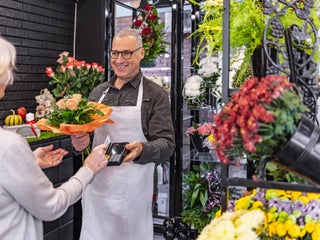Summary
Dining out with a large group, splitting the bill can be hectic. Learn how you can split the bill and how you could rack up rewards paying with a credit card.
The content on this page is accurate as of the posting date; however, some of our partner offers may have expired. Please review our list of best credit cards, or use our CardMatch™ tool to find cards matched to your needs.
Dining out is bouncing back. According to the National Restaurant Association’s 2022 State of the Restaurant Industry report, pent-up demand has increased, with 51% of those surveyed saying they weren’t eating at restaurants as often as they would like.
There’s nothing quite like the flurry of activity after a meal out with a group. When the bill arrives, credit cards may fly across the table and lighthearted squabbles can break out. Some diners start to calculate what they owe to the penny while others become suddenly scarce. Meanwhile, the poor server tries to keep everything orderly.
So when you go, make it easier on yourself, your table-mates and the restaurant workers. Follow this guide to credit card protocol for dining out and you can also come out ahead with significant credit card rewards.
Plan payment arrangements
If your party is bigger than just two people, a short discussion regarding how the bill will be managed beforehand is ideal. As the organizer, a group message like, “To simplify, I’ll be paying and you can reimburse me when we’re there. Looking forward to tonight!” is a polite gesture. As a guest, you might ask the host how the bill will be managed so you can be ready.
It’s not always this organized or easy, of course. You may not know everyone or feel comfortable addressing the matter. Unfortunately, not having this information opens the door to confusion and problems.
“As a customer and an owner, I always dread the end of meal check for large groups unless it’s a very close circle of friends,” says Alfredo Angueira, long-time restaurateur and founder of the New York City-based catering company, Hoodspitality. “Inevitably there is an issue. The person who ordered the lobster while everyone else had salad and wants to split the bill, or alligator arms who will sit there all night with you, never reaching for their pockets.”
Even when there is an agreement, problems can ensue. Ian Sells, CEO and founder of RebateKey, frequently dines with a large group of friends. They’ve established a pattern of paying for only what they ordered, but issues continue to erupt, as each person tries to calculate the correct portion of the bill.
“One time, the process took so long that a friend just stood up and paid everything with his credit card then went to each individual and asked whatever amount they were willing to give him – just to get the whole payment chaos over with,” says Sells.
Split or separate checks: Know the difference
When dividing the bill, know that there are two basic ways to do so:
- Split check: You can split the bill evenly by a desired number of ways. For example, if the bill comes to $300 and you want to split it five ways, each of you will hand over your individual cards and be charged $60. You will each have a separate receipt that you can sign and add gratuity.
- Separate check: Instead of everybody paying an equal slice of the bill, you would ask for separate checks that list only your food and beverages, then use your card and make the payment.
So what’s better? That depends. Split checks require less work for the server than separate checks, but they don’t allow for differences in individual spending. The salad eater shouldn’t have to supplement the lobster eater’s meal.
Limit the number of cards
Whichever way you want to divide the bill, restaurants may cap the number of cards or deny multiple payers altogether.
Angueira says he makes every attempt to be accommodating, but there are limits.
“As a general rule we don’t like splitting a bill between more than six guests,” he says. “We always have discretion and flexibility depending on the circumstances but splitting a bill more than that many times presents a host of problems. First, you’re bogging down your server by running so many cards. In a busy restaurant, they are creating a bottleneck at the POS (point of sale) station. This bottleneck can put a delay on other servers closing out their customers and slowing down overall service and turn around.”
The size of the bill matters, too. “If I get six cards for a $40 dollar bill I would be less than pleased,” says Angueira. “But if I had to do six cards for a $6,000 bill, I am far less annoyed.”
Before you go, contact the business and ask about their policy. If they don’t allow multiple payers, someone will be stuck with the entire bill. That can be a major problem if no one can cover the cost with cash or has enough capacity on their credit card.
The single payer method
In addition to breaking the bill apart, one person can cover the entire amount and then be reimbursed. Certainly, this single payer method is easier on the server.
Decide who the primary payer will be before you go, or at the very least before the bill arrives. It will offset the theatrics of someone grabbing the check, proclaiming that the meal is on them, while everyone else protests and lunges for the check. This can put the server in a very awkward position, especially when that person makes a great show of shoving the card into the server’s hand with a warning to not allow anybody else to pay.
If you elect to be the primary, check to see that your credit card has sufficient available credit for the whole charge. It will save you the embarrassment of the server informing you that your card was declined.
You also have to make sure that everyone repays you for the correct sum, and quickly. This is where payment apps such as Venmo, PayPal and Zelle shine. Request that everybody send you the money electronically. In seconds, the funds will be in your account.
In the absence of apps you can accept the classics: cash or check, but if they can’t pay you on the spot, problems can occur. Some may forget to reimburse you or avoid paying you back, which will put you in the uncomfortable position of being a debt collector.
Worse, if you do get stuck with a large portion of the bill and you don’t pay the entire bill by the due date, interest will be assessed and the meal will be even more expensive. And if the charge uses a significant portion of your card limit, it will hurt your credit utilization ratio, which can negatively impact your credit scores.
Enjoy the credit benefits of being the primary payer
If you want to be the single payer and use your credit card, prepare for the benefits. Some credit cards offer higher rewards when the card is used at restaurants.
For example, Capital One SavorOne Cash Rewards Credit Card offers 3% cash back on dining. Imagine you are out with 10 people and the bill comes to $900. If you pay for everything, the cash back rewards would total $27.
Another option is the American Express® Gold Card, which offers 4X Membership Rewards® Points at restaurants. When redeemed for travel, they’re worth 1 cent each, giving you a $36 value for the same $900 charge.
Just make the full payment within your interest-free grace period so finance fees won’t erode the value of the rewards. To prevent that from happening, use the app on your mobile device and send the amount you just charged as soon as everyone has reimbursed you.
In fact, this pay-as-you-charge habit can improve your credit. You’re proving that you can manage money and credit products like a pro. For this reason, Dominic Harper, founder of Debt Bombshell, says he always prefers being the person who charges a large group’s meal.
“This way I’m able to build transactions on my credit card and increase my credit card score as well, as I can tender payments for that purchase right away,” says Harper, who has even gamified the process with his dining mates.
“There was this one time when almost everyone wanted to pay with cards already, so we thought that playing the game where who pays first gets that benefit would work, and it did. Since then it has become a fun familiar thing that we do whenever I go out with that circle.”
Before you go, leave with the right card
Eventually, the meal will come to an end. If many people have paid, the cards will all come back simultaneously. The last protocol tip is to check the card to ensure it sports your name and not someone else’s.
Several diners may have accounts with the same credit card issuer so the cards will look alike. It’s easy to sign someone else’s bill and leave with their card. Aside from the inconvenience of arranging a switchback, someone else has access to your credit card account – and that can result in serious indigestion.
Editorial Disclaimer
The editorial content on this page is based solely on the objective assessment of our writers and is not driven by advertising dollars. It has not been provided or commissioned by the credit card issuers. However, we may receive compensation when you click on links to products from our partners.





